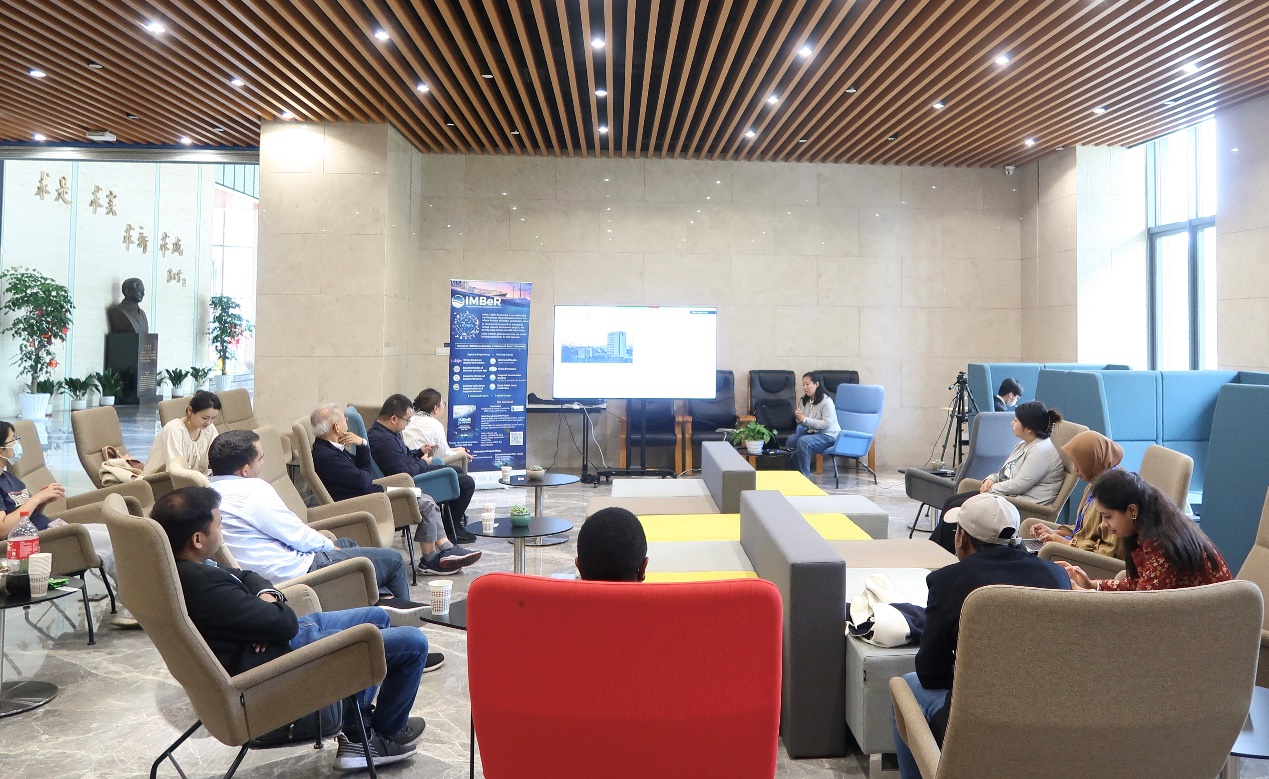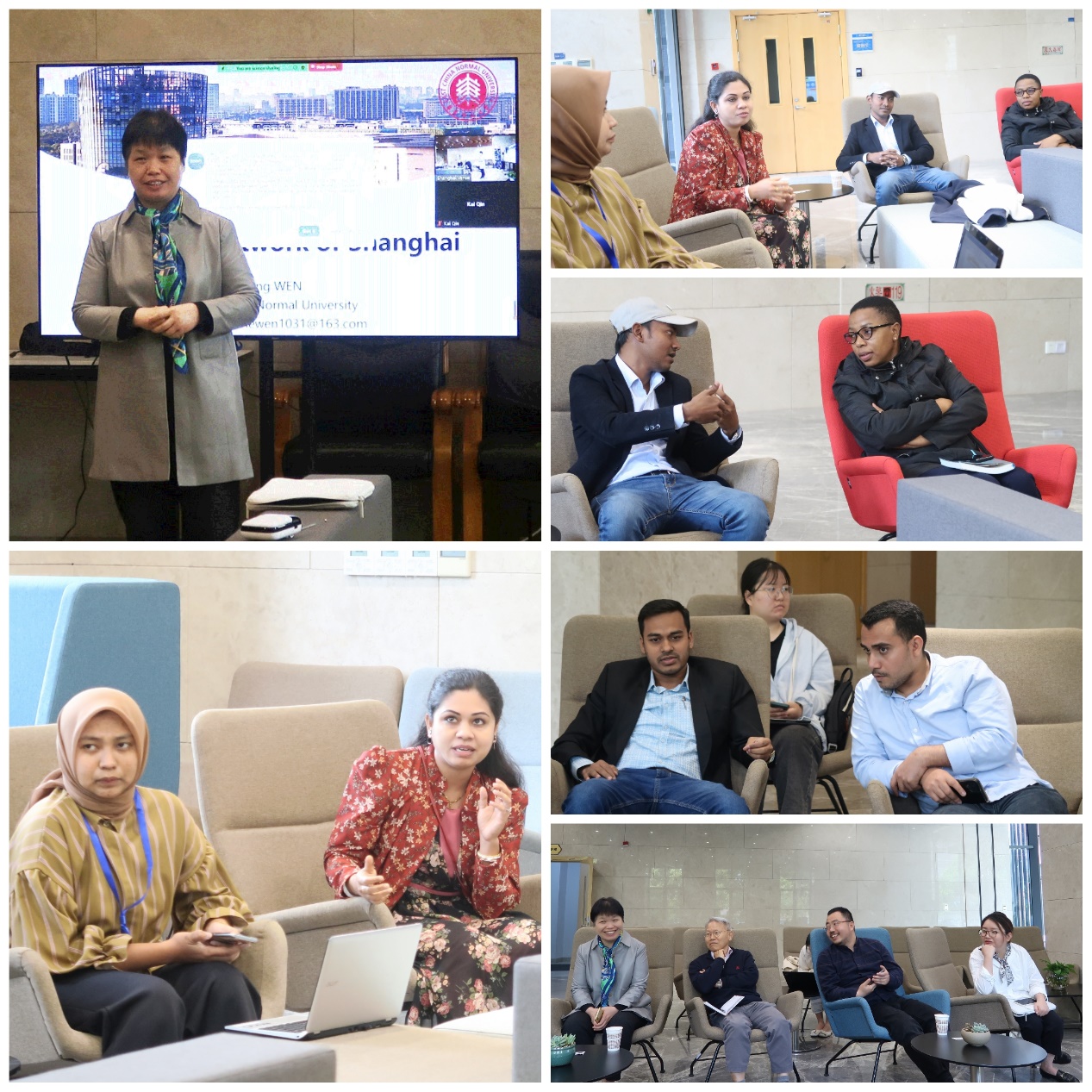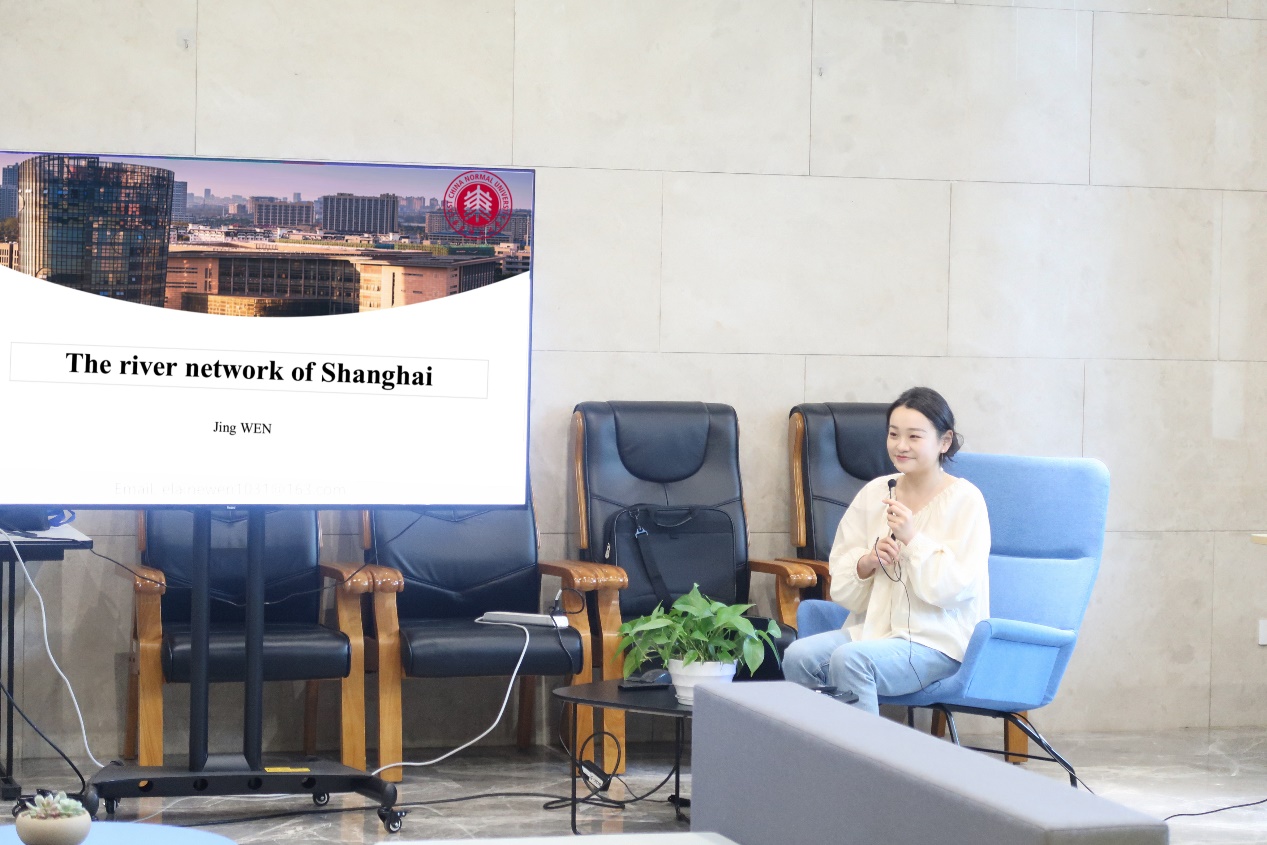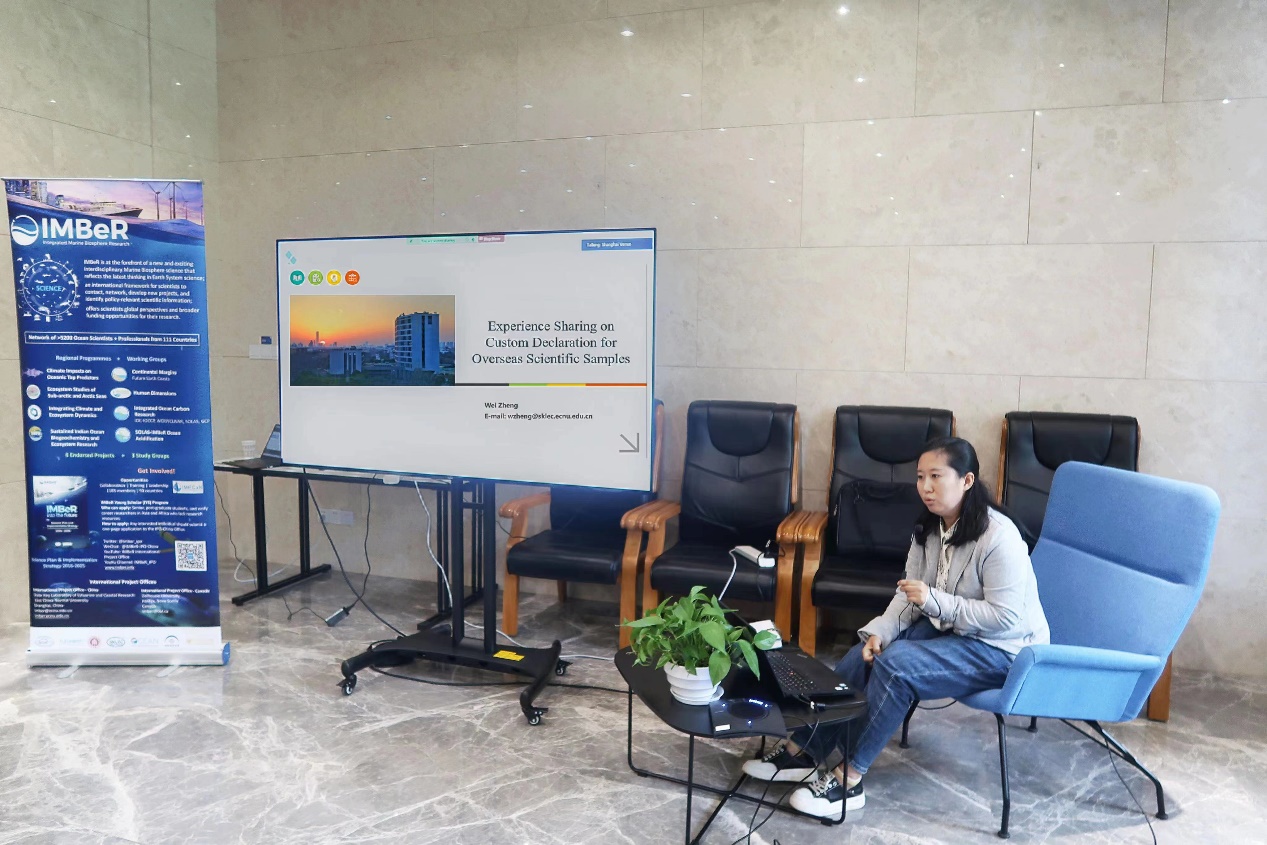
On 10 May 2023, the IMBeR International Project Office (IPO-China) held its second IMBeR Coffee Reception at the SKLEC building, ECNU, featuring two captivating presentations. Jing WEN, a postgraduate student from the School of Urban and Regional Science and an intern at IMBeR IPO-China, presented “The River Network of Shanghai”, offering a historical account of Shanghai’s waterways. Wei ZHENG from SKLEC shared her insights on “Customs Declaration for Overseas Samples”, providing a detailed overview of the transportation process for samples from abroad. This capacity-building event, targeting international students from SKLEC and IMBeR IPO-China interns, garnered the attention and participation of many teachers and students from relevant fields.

The event commenced with a welcoming speech by Professor Xiuzhen LI, Deputy Director of the Institute of Estuarine and Coastal Research, who warmly welcomed international students from different countries and regions to pursue further studies at SKLEC. She encouraged them to make use of the international platform of SKLEC to enhance communication, and actively participate in the activities organized by international project offices, to better adapt to their school life in Shanghai.

Over the span of 700 years, the river network of Shanghai has undergone significant transformations, witnessing the rise and development of the city. During her presentation, Jing WEN guided the attendees through the evolution of Shanghai’s waterways, shedding light on their historical origins. Suzhou Creek, originally known as “Song Jiang” (“Pine River”), was renamed “Wusong River” in 1278A.D. when the Huating Fu (Prefecture) changed its name to Songjiang Fu. As a tributary of Huangpu River and a vital outlet for Taihu Lake, Wusong River has not only served as the lifeline for transportation throughout history, but has also played a significant role in Shanghai’s development. She vividly depicted the development of Shanghai’s river network since the Yuan, Ming and Qing dynasties, as well as its pivotal role in urban development. She also narrated interesting historical anecdotes, such as the inspection of “Wusong River” by Yuanji XIA, a Ming Dynasty government minister who presided over the merging of the Wusong River and Huangpu River, and opposed He ZHENG's overseas voyages. The audiences immersed themselves in her informative narration, gaining a deeper understanding of historical details and embracing the charm of history.

Have you ever wondered about the complexities of transporting samples from overseas to China? Are you confused about the procedures before and after sample transportation that require special declarations? At the event, Wei ZHENG drew upon her own experiences to provide a lucid and accessible introduction to the transportation and declaration processes for various types of samples. Ensuring compliance is crucial when handling samples that require special declarations. She elaborated on the types of samples that require special declarations and outlined the necessary steps to be taken before and after the arrival of the samples, including some specific procedures and regulations that must be followed. For example, marine sediment samples require supporting documents from the institution and a sample list, as well as a special permit issued by the General Administration of Customs of China. Her detailed presentation offered a concrete and concise understanding of the sample transportation and customs declaration process to the audience, who found her experience sharing to be a valuable reference for their future research.
Following the presentations, faculty and students engaged in further discussion during the coffee reception, exchanging ideas about the presentations and sharing updates on their own research progress.
Aligned with SKLEC’s international initiatives, this is the second lecture event of the ongoing capacity development activities hosted by IMBeR IPO-China. These activities aim to provide early career researchers with invaluable learning and communication opportunities to help them adapt to diverse learning environments, broaden their international perspectives, and enhance their overall abilities.
Stay tuned for the upcoming event!
IMBeR能力发展活动:寻踪上海河道变迁,亲闻海外样品运输

2023年5月10日上午,IMBeR国际项目办公室(IPO-China)在河口海岸大楼一楼举办了第二次IMBeR Coffee Reception活动,带来了两个精彩详实的报告分享。来自城市区域与科学学院的IMBeR IPO-China实习生闻静的“历史上的上海河道”追溯了上海河道的历史变迁。河口海岸学国家重点实验室郑薇老师的“海外实验样品报关经验分享”详述了海外实验样品的运输及报关流程。作为面向河口海岸学国家重点实验室国际学生和IMBeR实习生的能力发展活动,本次活动也得到了相关专业领域的老师和学生的关注和参与。

活动在河口海岸科学研究院副院长李秀珍教授的欢迎辞中拉开帷幕。李老师热情地欢迎来自不同国家和地区的留学生来到实验室深造,并鼓励大家能够借助实验室的国际平台加强交流,积极参与各个国际项目办公室组织的活动,更好地适应在上海的学习生活。

上海的河道历经七百多年沧桑变迁,见证了城市的崛起和发展。报告中闻静带领与会者们一道寻踪上海河道的变迁,一窥其中的历史渊源。苏州河,古称“松江”。公元1278年,当时的华亭府改称为松江府以后将原来的松江冠以吴淞江之名。吴淞江作为黄浦江的支流和太湖水的重要外泄渠道,不仅在历史上充当了交通运输的命脉,也为上海的发展做出了卓越贡献。她生动地介绍了自元明清各朝代以来的上海河道发展历程以及其在城市发展中所扮演的重要角色。闻静将明代官员夏原吉视察吴淞江、主持实现江浦合流、反对郑和远航等历史趣闻娓娓道来。观众们沉浸在她翔实地讲述中,了解历史的细节、感受历史的魅力。

你是否曾面临过如何将海外实验样品运输至国内的困惑?是否对于需要特殊申报的样品及样品运输前后的步骤一头雾水?活动现场郑薇老师结合自身工作经验,条分缕细地介绍了不同种类实验样品的运输和申报流程。当涉及需要特殊申报的样品时,确保合规性至关重要。她详细解释了需要特殊申报的样品类型以及样品到达前后需要采取的必要步骤,包括一些必须遵循的特定程序和规定。例如,海洋沉积物样品需要提供单位支持文件和样品清单,并获得中国海关总署颁发的特别许可证。郑老师的详细介绍让国际学生们对样品的运输和报关流程有了具体而清晰的认识。他们纷纷表示这样的经验分享为自己今后的科研工作提供了很切实的帮助。

报告结束后,在场师生在咖啡午餐会上继续交流,就报告内容、彼此的研究进展等展开了轻松且热烈的交流。
此次活动是在国重室国际化工作引领下,IMBeR国际项目办公室(中国)举办的能力发展系列活动第二次专题讲座交流会,旨在为国内外青年学生提供更多有益的学习和交流机会,帮助他们更好地适应多元化的学习和生活环境,在轻松愉快的氛围中探讨学术观点、拓展国际化视野、提升综合素养。
敬请期待下期活动!
图 | 林秋汛、申奥
文 | 秦恺
编辑 | 孟石芳、左芳








